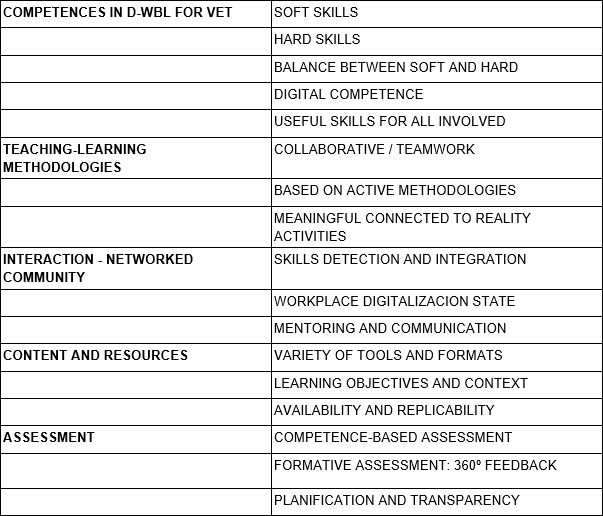3 Good Practices in D-WBL
Digital Work-Based Learning combines digital teaching-learning with digital activities in the labour market. But the complexity to deal within the place where students, teachers, entrepreneurs and workers meet is a big challenge.
The table below presents 10 key components of online teaching and learning and their main characteristics.
These 10 key components emerge from the work done by Universitat Oberta de Catalunya (UOC) and International Association of Universities (IAU) which has resulted in the launch of the online IAU-UOC series of six chapters discussing: Innovative Education for Unshaped Futures (IE4UF) and in an accessible series of articles and recommendations for the design and implementation of quality online teaching and learning and in the publication “Improving Online Teaching. Practical Guide for Quality Online Education” (Sangrà et al., 2022), covering topics ranging from the organization of online education models to their assessment, including the design of courses, activities and teaching strategies, collaboration between teachers and students, mediation and interaction, feedback, digital tools, and the generation of critical attitudes of the students themselves towards technology.

Based on these 10 key components, WBL and VET-particular considerations, this guide selects 5 components and between 3 to 5 elements of each of them. For example, as the network in VET involves students, teachers, administration and entrepreneurs, component 1 (Students) and component 8 (Teachers) from 10 key components of online teaching and learning are now under the common umbrella of component INTERACTION – NETWORKED COMMUNITY.
Table below shows the five components and the 17 elements that a good practice in D-WBL should incorporate. These components emerge from the analysis of scientific literature and the D-WBL participants’ experience: students, teachers, administration staff and entrepreneurs, all of them with experience in D-WBL.

In the following pages, each component is briefly explained and some selected literature or participants’ contributions are presented as examples.
Once the components and their elements are presented, section 4 provides a tool to evaluate the degree of concordance between a specific digital VET practice and each element.
